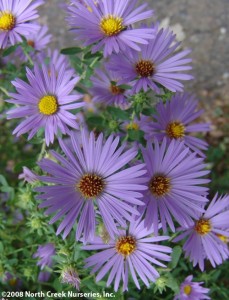Aromatic asters (Aster oblongifolius) is one of our finest late blooming native asters for the autumn garden in the Southern Appalachian region (USDA zones 6 and 7). Through the spring and summer months, the dense gray-green shrubby foliage mounds grow 15-18 inches high and 24-30 inches wide. Hundreds of yellow-centered, daisy type flowers cover the plants. Blooms average 1 1/4 inches in diameter. The foliage emits a minty fragrance when crushed.
The botanical nomenclature of aromatic asters was recently changed to Symphyotrichum oblongifolium. The two most popular cultivars are ‘October Skies’ with bluish ray flowers and ‘Raydon’s Favorite’, a sister seedling, with blue-lavender ray flowers. Both cultivars work well as part of a border or meadow planting, or in containers. Like most asters, flowers attract numerous butterflies and are excellent cut for a table arrangement.
Aromatic asters grow in an average soil and in full sun. In gardens asters benefit from additions of compost and fertilizer to the garden soil. Established asters are very drought tolerant. Immediately after flowering, deadhead plants to reduce seed formation which may lead wild seedlings germinating in your garden in subsequent years. Using a sharp knife, split apart and tranplant emerging mounds of young shoots in early spring.
Aster yellows is a virus disease and their mortal “Achilees’ heel”. The yellow virus is spread by sap feeding insects such as leafhoppers and aphids in spring and early summer. Prevention is your only option, using contact-type insecticides. Aromatic asters demonstrate better than average deer resistance if populations are not exceptionally high.


 Posted in
Posted in 
